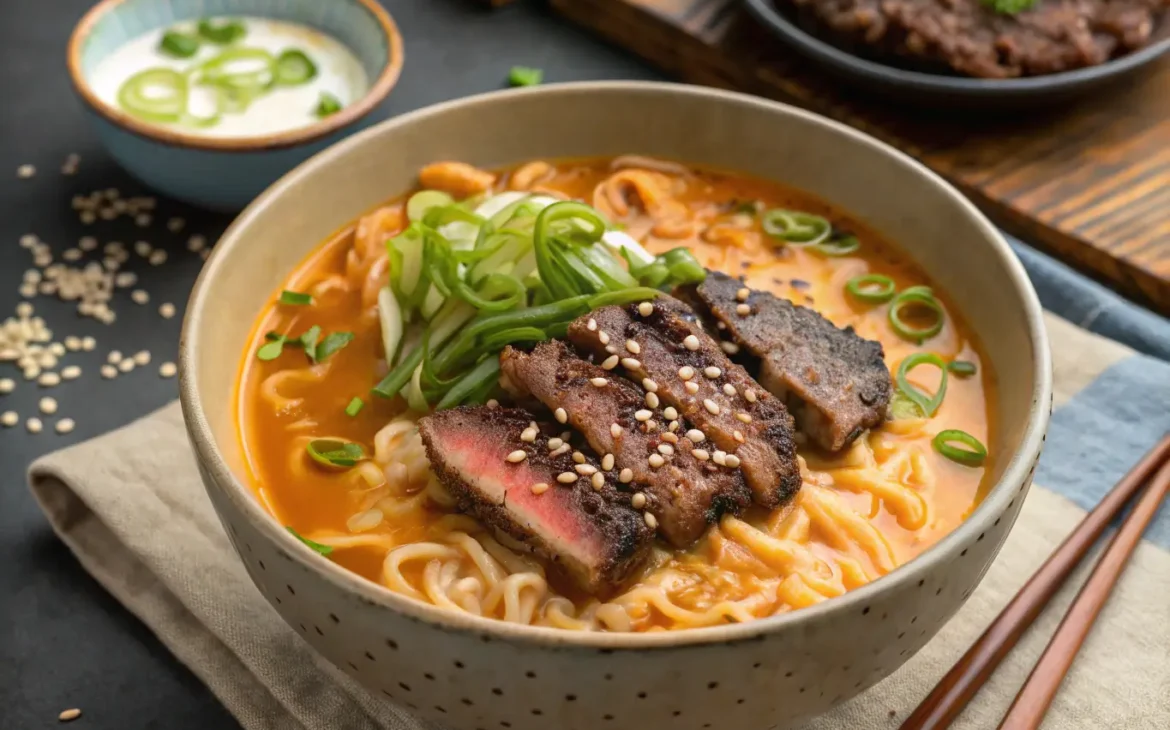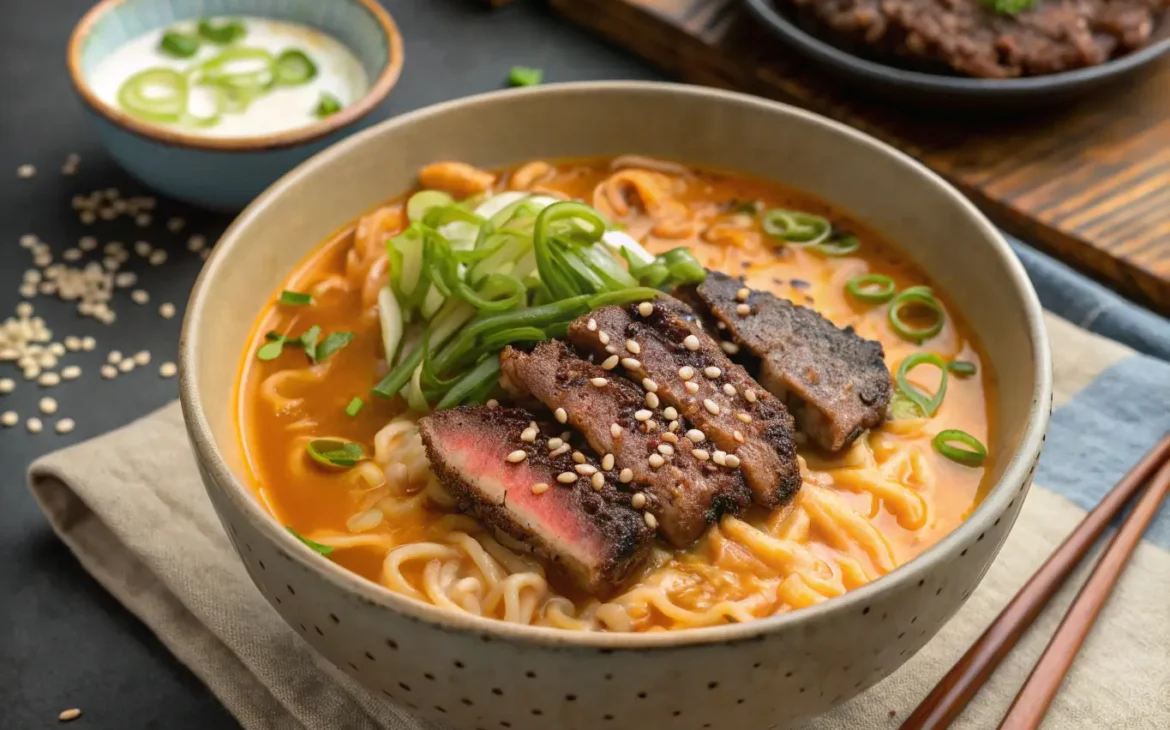Ultimate Spicy Korean Ramen with Grilled Beef & Creamy Sauce (라면 불고기): A Gourmet Comfort Food Experience
🔥 Introduction: Elevating Instant Ramen to Restaurant Quality
In Korea, ramen (라면) is more than just a quick meal—it’s a cultural phenomenon. While instant ramen makes for an easy snack, this Spicy Korean Ramen with Grilled Beef & Creamy Sauce transforms humble ingredients into a luxurious dining experience. Imagine:
- Perfectly marinated, caramelized grilled beef inspired by bulgogi
- A rich, velvety broth that balances spicy gochujang with creamy indulgence
- Springy, chewy noodles that hold onto every drop of sauce
- An array of colorful toppings adding texture and freshness
This dish represents the modern evolution of Korean comfort food, where convenience meets gourmet flavors. Whether you’re craving something deeply satisfying after a long day or want to impress guests with minimal effort, this recipe delivers bold flavors, contrasting textures, and visual appeal—all in about 30 minutes.

Why This Recipe Stands Out
✔ Restaurant-quality results using smart techniques
✔ Customizable spice level for all heat preferences
Meal-prep friendly components
✔ Uses affordable ingredients with maximum flavor impact
🌶️ The Cultural Context: Ramen in Korean Cuisine
History of Ramyeon in Korea
Korean ramen has its roots in Japanese ramen but developed unique characteristics:
- 1963: The birth of Samyang Ramyun, Korea’s first instant noodle
- 1986: Shin Ramyun revolutionized the market with its spicy flavor
- Today: Over 100 varieties exist, from jjajang (black bean) to cheese ramen
The Rise of “Gourmet” Ramen Trends
Recent years have seen Koreans elevating instant noodles through:
- Adding premium proteins like grilled beef or seafood
- Creamy variations using milk, cheese, or heavy cream
- Restaurant-style plating with artful toppings
This recipe captures all these modern trends while staying true to Korean flavor fundamentals.
🥩 The Science Behind Perfect Grilled Beef
Choosing the Right Cut
| Cut | Characteristics | Best For |
|---|---|---|
| Ribeye | Well-marbled, tender | Luxurious texture |
| Sirloin | Leaner but flavorful | Healthier option |
| Flank | Beefy flavor | Budget-friendly |
Pro Tip: Freeze beef for 30 minutes before slicing for paper-thin cuts.
Marination Chemistry
The marinade works through:
- Enzymatic tenderization (ginger)
- Flavor penetration (sugar and soy sauce)
- Umami development (gochujang fermentation)
Optimal Marinating Time:
- 15 minutes: Good flavor
- 2 hours: Deeper penetration
- Overnight: Maximum tenderness (reduce salt if marinating >4 hours)
🍜 Mastering the Creamy Spicy Broth
Flavor Layering Technique
- Base: Anchovy or beef broth provides depth
- Umami: Doenjang (fermented soybean paste) adds complexity
- Heat: Gochujang brings sweet-spicy notes
- Creaminess: Heavy cream balances the heat
Temperature Control:
- Simmer broth gently after adding cream
- Avoid boiling to prevent separation
Ingredient Substitutions
| Original | Substitute | Notes |
|---|---|---|
| Doenjang | Miso paste | Similar fermented depth |
| Heavy cream | Coconut milk | Dairy-free option |
| Gochujang | Sriracha + honey | Different but workable |
👨🍳 Detailed Step-by-Step Instructions
1. Beef Preparation (15 mins active + marinating)
- Slice Technique: Cut against the grain at 45° angle for tenderness
- Marinate: Massage mixture thoroughly into beef
- Cook: High heat creates Maillard reaction (flavor development)
Doneness Guide:
- Medium-rare: 130°F (54°C)
- Medium: 140°F (60°C)
2. Broth Development (10 mins)
- Bloom Flavors: Toast gochujang in butter first
- Deglaze: Use some marinade for extra flavor
- Emulsify: Whisk constantly when adding cream
3. Noodle Perfection (4 mins)
- Cook separately to control texture
- Shock in ice water for extra chewiness (optional)
🍽️ Art of Plating: Korean Aesthetics
Traditional vs. Modern Presentation
| Traditional | Modern |
|---|---|
| Simple bowl | Deconstructed plating |
| Few toppings | Abundant garnishes |
| Focus on function | Instagram-worthy |
Topping Arrangement Guide
- Base: Noodles slightly peeking through broth
- Protein: Fan out beef slices
- Egg: Centered for yolk porn
- Vegetables: Color contrast (green onions, red kimchi)
- Finishes: Sesame seeds, nori flakes
🌡️ Heat Level Customization
Scoville Scale Adaptation
| Level | Adjustments |
|---|---|
| Mild | 1 tsp gochujang |
| Medium | 1 tbsp gochujang |
| Fire | Add 1 tsp gochugaru (Korean chili flakes) |
Cooling Counterbalances:
- Extra cream
- Cucumber slices
- Milk-based drinks
♻️ Sustainability & Budget Tips
Reducing Food Waste
- Use vegetable scraps for homemade broth
- Repurpose leftover beef in fried rice
Cost-Cutting Swaps
- Chuck roast (thinly sliced) instead of ribeye
- Make your own gochujang substitute:
- 2 tbsp red pepper flakes
- 1 tbsp fermented soybean paste
- 1 tsp sugar
- 1/4 cup water
📊 Nutritional Optimization
Macronutrient Breakdown (Per Serving)
| Nutrient | Amount | % DV |
|---|---|---|
| Calories | 650 | 33% |
| Protein | 38g | 76% |
| Fat | 32g | 49% |
| Carbs | 55g | 18% |
Healthier Modifications
- Lower fat: Use lean sirloin + evaporated milk
- Higher protein: Add soft tofu
- Low-carb: Shirataki noodles + extra vegetables
🕒 Time-Saving Strategies for Busy Cooks
Meal Prep Components
| Component | Storage | Reheating |
|---|---|---|
| Marinated beef | 3 days fridge | Skillet 2 mins |
| Broth base | 5 days fridge | Gentle simmer |
| Prepped toppings | 2 days fridge | Room temp |
Express Version (15 mins)
- Use pre-sliced “bulgogi style” beef
- Microwave-safe noodle cooking
- Pre-made spicy mayo instead of from-scratch sauce
🍷 Pairing Suggestions
Beverage Matches
| Type | Recommendation | Why It Works |
|---|---|---|
| Beer | Hite/Max/Cass | Cleanses spice |
| Soju | Grapefruit flavor | Citrus cuts richness |
| Wine | Off-dry Riesling | Balances heat |
Side Dish Pairings
- Kimchi pancakes (buchimgae)
- Sesame spinach (sigeumchi namul)
- Crispy seaweed snacks
❓ Expanded FAQ Section
Q: Can I make this vegetarian while keeping it authentic?
A: Yes! Use:
- King oyster mushrooms (sliced thin) as beef substitute
- Kombu dashi for broth base
- Extra doenjang for umami
Q: Why do Koreans often cook ramen twice?
A: The “twice-cooked” method:
- Parboil noodles to remove excess oil
- Finish in broth for better flavor absorption
Q: My sauce separated—how to fix it?
A: Try:
- Immersion blender to re-emulsify
- 1 tsp cornstarch slurry while reheating

🌡️ Troubleshooting Guide
| Issue | Cause | Solution |
|---|---|---|
| Tough beef | Overcooked | Slice thinner, cook hotter/faster |
| Bland broth | Underseasoned | Add fish sauce or MSG pinch |
| Mushy noodles | Overcooked | Reduce time by 1 minute |
🎉 Final Thoughts: More Than Just Ramen
This Spicy Korean Ramen with Grilled Beef & Creamy Sauce represents the beautiful evolution of Korean comfort food—where convenience meets craftsmanship. By understanding the techniques behind each component, you’re not just making a meal, but:
- Honoring Korean culinary traditions
- Mastering flavor-balancing skills
- Creating a customizable template for endless variations
Whether you enjoy it as a quick solo dinner or centerpiece for gatherings, this dish promises bold flavors, satisfying textures, and the soul-warming comfort that makes Korean cuisine beloved worldwide.
Ready to experience the ultimate ramen upgrade? Your taste buds are in for a thrilling ride! 🚀🍜🔥
(Pro Tip: Double the beef marinade and freeze half for future quick meals!)

